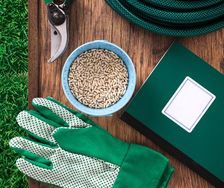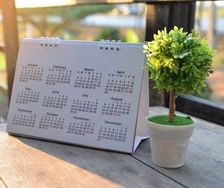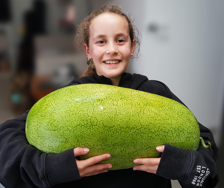Yates Account
Join now
Create a Yates account today!
Sign up to join the Yates Garden Club for monthly e-mails packed with seasonal inspiration, tips for success & exclusive promotions.
Plus if you’re a Garden Club member you can take part in the Yates Growing Community - a blog to share successes, get advice & win prizes in fun challenges along the way!

Forgot password
Enter the email address associated with your account, and we'll email you a new password.
Hemiptera

What are Scale Insects?
There are many species of scale, and they can look very different to one another! Scale insects rarely move, spending most of their lives stationary, hiding under an exterior coating and feeding on plant sap. They drive straw-like mouthparts (called a ‘stylet’) into plant cells and suck out the contents, which eventually causes severe stress and injury to the plant. Damage to plants becomes much worse when the scale population gets high.
There are two main groups of scale insects:
- Hard Scales build themselves a shell-like shield (called a 'test') to hide under, although this hard cover isn't actually attached to their soft, sack-like bodies, it rests on top of them. The protective shield makes them more challenging to control than most insects, because it can insulate them from contact insecticides.
Also known as 'armoured scale', these species are quite well disguised: they often look like hard, raised bumps on leaves and stems.
- Soft Scales secrete flexible waxy or mealy-looking coatings to conceal themselves. The name of this group is a bit misleading, because their coverings can be either soft or hard. The key difference that separates the species in this group is that their outer coating is physically attached to the scale's body. Soft scales with a waxy exterior can also be hard to kill with contact insecticides, so they usually need to be controlled with specific products.
Another difference is that soft scales excrete a lot more honeydew after feeding, so they're usually accompanied by sooty mould and ants. Ants adore honeydew, so they often act as 'bodyguards' for scale. By protecting scale from predators, ants can harvest a regular supply of sugary honeydew.

Ants 'farming' a scale insect for honeydew.
Most scale species lay eggs that hatch into tiny nymphs, or 'crawlers' (a few species bear crawlers as live young). These crawlers move a short distance to a new feeding site, where they set up home for good.
Scales moult twice during their life cycle - fascinatingly, hard scales recycle their own cast-off skins as raw material to build their armoured shell.
Hard scales become completely immobile as adults, because they no longer have legs (they don't even bother to keep their eyes). Soft scales do retain legs into adulthood, although they generally don’t move around.

San José Scale (Quadraspidiotus perniciosus) on a pear tree
Hard Scales
A commonly encountered hard scale is San José Scale (Quadraspidiotus perniciosus), which you might find on apple, pear, peach, plum, currants, grapes, walnuts or ornamentals. Tiny (1.5mm in diameter) and shaped a bit like a barnacle, it's grey in colour with a lighter centre. San José scale tends to cluster on the bark of trees, where it forms encrustations of scale that can kill off entire branches if not controlled.
San José scale can also damage the appearance of fruit, causing red spots and pitting.

Oyster-Shell Scale (Diaspidiotus ostreaeformis)
© Gilles San Martin – some rights reserved (CC BY-SA)
The related Oyster-Shell Scale (Diaspidiotus ostreaeformis) is also quite small, from 1.5mm-1.9mm. Colour changes from pale yellow to dark grey, with a brighter yellowy-orange centre (this is what remains of the moulted skin).
It prefers apple. pear, plum and cherry trees, where it's generally found on trunks and branches, although it also infests fruit and causes pitting and red blemishes. It’s often found concealed under loose bark.

Apple Mussel Scale (Lepidosaphes ulmi)
Apple Mussel Scale (Lepidosaphes ulmi) has a distinctive elongated, mussel-shaped shell. Colour ranges from pale grey to dark brown, camouflaging them exceptionally well on bark. It has an appetite for a wide range of plants, including pipfruit, stonefruit and currant bushes.
These two species, along with San José scale, are particularly problematic pests of apples and pears in NZ.

California Red Scale (Aonidiella aurantii) on a tangerine skin
California Red Scale (Aonidiella aurantii) attacks citrus, along with kiwifruit, roses, orchids and pūriri trees. The insects have a reddish-brown hard shell, with a couple of concentric rings visible. The shape is quite flattened and semi-circular, about 2mm in diameter.

Oleander Scale (Aspidiotus nerii)
There are three common pests of kiwifruit, avocado, persimmons, citrus and ornamental trees that can be difficult to tell apart: Greedy Scale (Hemiberlesia rapax), Latania Scale (Hemiberlesia latania) and Oleander Scale (Aspidiotus nerii) all look similar and share the same favourite plants.
These species have slightly irregular domed shields, off-white to light brown in colour, with concentric rings and a darker bump in the centre.

Rose Scale (Aulacaspis rosae)
Rose Scale (Aulacaspis rosae) infests roses, raspberries and blackberries. It has a flat, circular, downy-textured wax coat. It’s a grubby-looking greyish white in colour, often with a darker spot in the centre. When well-established, rose scale forms distinctive waxy encrustations on stems.
Soft Scales
Soft scales are a lot more variable in appearance than the hard species.
One of the more distinctive soft scales is Cottony Cushion Scale (Icerya purchasi) which you may find on kiwifruit, citrus, apples, figs, roses or a wide range of native trees. About 5mm long, it extrudes a unique white grooved egg sac that grows out behind it.

Cottony Cushion Scale (Icerya purchasi)
Chinese Wax Scale (aka Hard Wax Scale, Ceroplastes sinensis) is a particular pest of citrus and feijoas. It forms a blobby-looking dome of pinky-white wax. Their nymphs resemble little white stars.
Soft Wax Scale (Ceroplastes destructor) is a related species, that shares the same taste in plants. Although they both have a thick coat of wax, Chinese Wax Scale has a very hard wax covering, while Soft Wax Scale forms a soft white blob that feels wet to the touch.

Chinese Wax Scale (Ceroplastes sinensis)

Soft Wax Scale (Ceroplastes destructor)
Olive Scale (aka Black Scale, Saissetia oleae) attacks citrus, grape vines, hibiscus, hydrangea, kiwifruit, olives, apricots, orchids, pears and roses. This scale grows a dark brown or black armoured dome, about 5mm in diameter.

Olive Scale (Saissetia oleae)
Brown Scale (Parthenolecanium corni) will infest cherry trees, plums, apricots, roses, currants or grape vines. Inspect stems for dark brown, slightly oval shaped hard shields, about 5mm long.
Similarly, Cottony Vine Scale (Pulvinaria vitis) is a nuisance for growers of peaches, apricots, pears, currants and grapes. This species starts with a hard, oval dark brown shield, about 6mm long. As the insect matures, it produces a white fluffy egg sac underneath itself, which pushes the shield to the side as it expands.
Both of these species are usually found on stems and under the leaves of affected plants.

Brown Scale (Parthenolecanium corni)
How to Protect Your Plants from Scale
Although most contact insecticides don't have any effect on scale because it's hidden under a shell, it's easily controlled with regular sprays of Yates Conqueror Spraying Oil, or Yates Natures Way Organic Citrus, Vegie Ornamental Spray sprayed directly onto the scale insects.
Spraying the stems and the undersides of the leaves, ensuring direct contact and good coverage of the scale, is important to get the best results.

Cottony Vine Scale (Pulvinaria vitis)
Symptoms of Scale Infestation
If your tree or shrub is dropping leaves, twigs and branches are dying back, if the fruit is stunted or distorted, if you’ve seen small yellow spots appearing on leaves, or you've noticed crusty white patches on stems. Any of these symptoms (or a combination of them) can indicate an infestation of scale.
Telltale symptoms of a scale infestation are ants speeding up and down plant stems (they're attracted to the sticky honeydew that scale excrete) and sooty mould, which grows on the honeydew residues. After you've controlled the scale insects and the source of the honeydew disappears, the ants and sooty mould will also depart.

Chinese Wax Scale (Ceroplastes sinensis)
Plants Impacted
- Citrus
- Apple & Pear
- Kiwifruit
- Feijoa
- Grape
- Stonefruit
- Avocado
- Figs
- Roses
- Orchids
- Ornamental & Shelterbelt Trees
- Magnolia
















Share
Share this article on social media